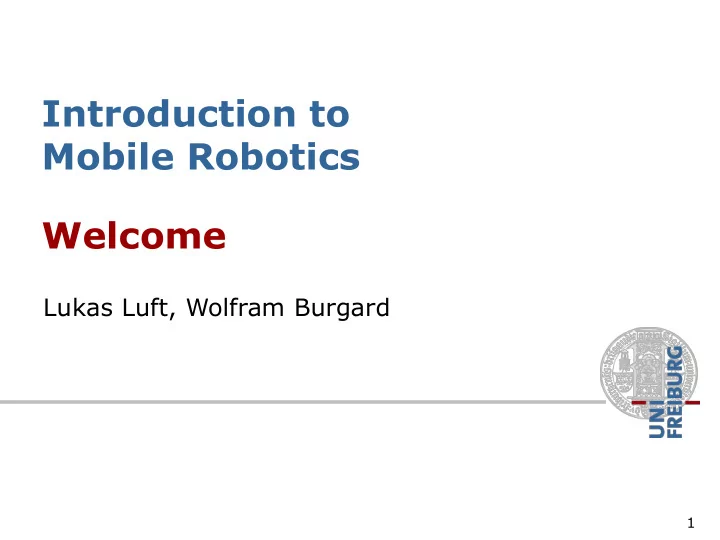

Introduction to Mobile Robotics Welcome Lukas Luft, Wolfram Burgard 1
Today This course Robotics in the past and today 2
Organization Wed 14:00 – 16:00 Fr 16:00 – 17:00 lectures, discussions Fr 17:00 – 18:00 homework, practical exercises (Python) Web page: www.informatik.uni-freiburg.de/~ais/ Exam: Oral or written 3
People Teaching: Wolfram Burgard Teaching assistants: Marina Kollmitz Johannes Meyer Iman Nematollahi Lukas Luft Daniel Büscher 4
Goal of this course Provide an overview of problems and approaches in mobile robotics Probabilistic reasoning: Dealing with noisy data Hands-on experience 5
Content of this Course 1. Linear Algebra 12. SLAM: Simultaneous Localization and Mapping 2. Wheeled Locomotion 13. SLAM: Landmark-based 3. Sensors FastSLAM 4. Probabilities and Bayes 14. SLAM: Grid-based FastSLAM 15. SLAM: Graph-based SLAM 5. Probabilistic Motion Models 16. Techniques for 3D Mapping 6. Probabilistic Sensor Models 17. Iterative Closest Points 7. Mapping with Known Poses Algorithm 18. Path Planning and Collision 8. The Kalman Filter Avoidance 9. The Extended Kalman Filter 19. Multi-Robot Exploration 10.Discrete Filters 20. Information-Driven Exploration 11.The Particle Filter, MCL 21. Summary 6
Reference Book Thrun, Burgard, and Fox: “Probabilistic Robotics”
Relevant other Courses Foundations of Artificial Intelligence Computer Vision Machine Learning and many others from the area of cognitive technical systems. 8
Opportunities Projects Practicals Seminars Thesis … your future! 9
Tasks Addressed that Need to be Solved by Robots Navigation Perception Learning Cooperation Acting Interaction Robot development Manipulation Grasping Planning Reasoning …
Autonomous Robot Systems perceive their environment and generate actions to achieve their goals. model sense environment act
Autonomous Robot Systems Sensor data Control system World model Actions 12
Robotics Yesterday 13
Current Trends in Robotics Robots are moving away from factory floors to Entertainment, toys Personal services Medical, surgery Industrial automation (mining, harvesting, …) Hazardous environments (space, underwater) 14
Shakey the Robot (1966) 15
Shakey the Robot (1966) 16
Robotics Today Lawn mowers Vacuum cleaners Self-driving cars Logistics … 18
The Helpmate System 19
Autonomous Vacuum Cleaners
Autonomous Lawn Mowers 21
DARPA Grand Challenge [Courtesy by Sebastian Thrun] 22
Walking Robots [Courtesy by Boston Dynamics]
Androids Overcoming the uncanny valley [Courtesy by Hiroshi Ishiguro]
Driving in the Google Car
Autonomous Motorcycles [Courtesy by Anthony Levandowski]
The Google Self Driving Car 29
Folding Towels
Rhino (Univ. Bonn + CMU, 1997) 31
Minerva (CMU + Univ. Bonn, 1998) Minerva 32
Robotics in Freiburg 33
Autonomous Parking
Autonomous Quadrotor Navigation Custom-built system: laser range finder inertial measurement unit embedded CPU laser mirror
Precise Localization and Positioning for Mobile Robots
Obelix – A Robot Traveling to Downtown Freiburg
The Obelix Challenge (Aug 21, 2012)
The Tagesthemen-Report
Brain-controlled Robots 40
Teaching: Student Project on the Autonomous Portrait Robot
Final Result
Other Cool Stuff from AIS 43
Accurate Localization KUKA omniMove (11t) Safety scanners Error in the area of millimeters Even in dynamic environments
26 Units installed at Boeing Fuselage assembly 20 vehicles to transport industrial robots for drilling and filling of 60,000 fasteners in 6 vehicles for logistics of parts, work stands and fuselages
Deep Learning to Manipulate from Parallel Interaction Source: Google Research Blog
Learning User Preferences Task preferences are subjective Fixed rules do not match all users Constantly querying humans is suboptimal How to handle new objects? Where does this go?
Collaborative Filtering • - • … • - ? • -
Collaborative Filtering • - • … • - • -
Online Prediction of Preferences
Localization in Urban Environments Inaccurate (if even available) GPS signal No map Limited Internet
Motivation
Example
Example contin. Text: irpostbankfmarzcenter tllgi Matched Landmarks: Postbank finanzcenter Text: melange Matched Landmarks: Melange Melange Text: casanova Matched Landmarks: Casanova
Example
Deep Learning Applications RGB-D object recognition Images human part segmentation Sound terrain classification
DCN for Object Recognition Fusion layers automatically learn to combine feature responses of the two network streams During training, weights in first layers stay fixed
Learning Results • [Lai et. al, 2011] • Category-Level Recognition [%] (51 categories ) Method RGB Depth RGB-D CNN-RNN 80.8 78.9 86.8 HMP 82.4 81.2 87.5 CaRFs N/A N/A 88.1 CNN Features 83.1 N/A 89.4 This work, Fus-CNN 84.1 83.8 91.3
Network Architecture Fully convolutional network Contraction and expansion of network input Up-convolution operation for expansion Pixel input, pixel output
Deep Learning for Body Part Segmentation • Segmentation • Input Image • Ground Truth mask
Deep Learning for Terrain Classification using Sound
Network Architecture Novel architecture designed for unstructured sound data Global pooling gathers statistics of learned features across time
Data Collection Wood Linoleu Carpet P3-DX m Cobble Asphal Mowe Paving Grass Offroa Stone t d d Grass
Results - Baseline Comparison (300ms window) [1] [2] [3] [4] [5] [6] 99.41% using a 500ms window 16.9% improvement over the previous state of the art [1] T. Giannakopoulos, K. Dimitrios, A. Andreas, and T. Sergios, SETN 2006 [2] M. C. Wellman, N. Srour, and D. B. Hillis, SPIE 1997. [3] J. Libby and A. Stentz, ICRA 2012 [4] D. Ellis, ISMIR 2007 [5] G. Tzanetakis and P. Cook, IEEE TASLP 2002 [6] V. Brijesh , and M. Blumenstein, Pattern Recognition Technologies and Applications 2008
Thank you … and enjoy the course! 67
Recommend
More recommend